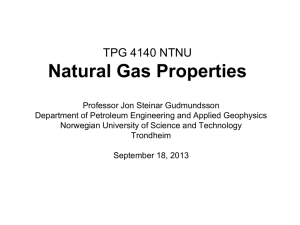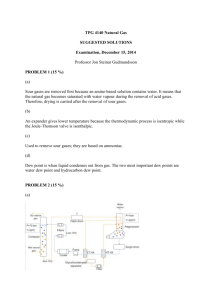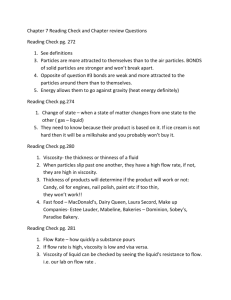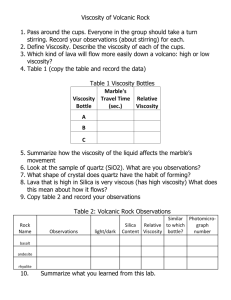Properties of Natural Gas
advertisement
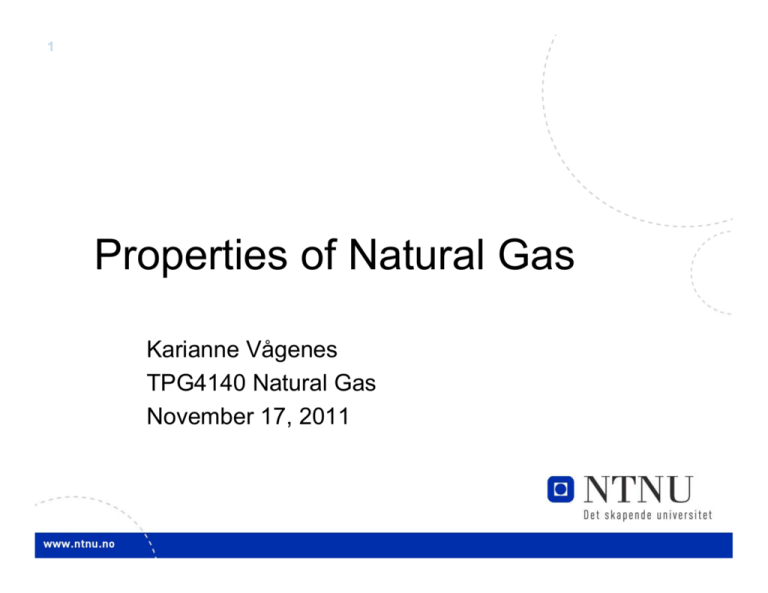
1 Properties of Natural Gas Karianne Vågenes TPG4140 Natural Gas November 17, 2011 2 Content • • • • Terminology Classification Composition Specification • • • • • Real Gas Law, z-factor Corresponding states Viscosity Heat capacity Summary 3 Terminology • Natural gas, C1-C5+, water, inert gases • NGL (Natural Gas Liquids), under pressure • LPG (Liquefied Petroleum Gas), propane + butane, -42 C • LNG (Liquefied Natural Gas), -162 C, 1 atm • CNG (Compressed Natural Gas), 200-300 bara • Condensate (liquid), C4-C7, transition gas-to-oil • Oil, C6 and heavier fractions 4 Terminology of Natural Gas Jahn et al. (1998) 5 Classification • Reservoir conditions – Non-associated (“dry gas”), produced alone (T > Tcricondemtherm) – Associated gas (“wet gas”), produced with oil • Well, pipeline and process conditions – – – – – Rich gas, from production platform Dry gas, no liquid fraction “Wet gas”, NGL, no gas phase present Condensate (Tcritical < T < Tcricondemtherm) Dense phase (p > pcritical) 6 Phase envelopes for reservoir fluids. C is critical point Pedersen et al. (1989) Properties of Oils and Natural Gases, Gulf Publishing Company 7 Pressure/temperature phase envelopes for main hydrocarbon types Jahn et al. 1998 8 Compositions, wellhead conditions R o j e 9 Composition, generalization Non-Associated (dry gas) Associated gas (wet gas) Methane > 90 volume % Methane < 90 volume % Sweet gas Sour gas CO2 < 2 volume % CO2 > 2 volume % Sweet gas Sour gas H2S < 1 volume % H2S > 1 volume % 10 Composition, Processed Gas Molecule Troll (1) Norway Sleipner (2) Norway Draugen (3) Norway Groningen (4) Netherlands Methane Ethane Propane Iso-Butane N-Butane C5++ Nitrogen Carbon-dioxide 93.070 3.720 0.582 0.346 0.083 0.203 1.657 0.319 83.465 8.653 3.004 0.250 0.327 0.105 0.745 3.429 44.659 13.64 22.825 4.875 9.466 3.078 0.738 0.720 81.29 2.87 0.38 0,15 0.04 0.06 14.32 0.89 100 100 100 100 (1) After processing at Kollsnes (on-shore processing plant), average for November 2000. (2) After off-shore processing into off-shore pipelines, combination of Sleipner East and West, average November 2000. (3) After off-shore processing into pipeline Åsgard Transport to Kårstø (on–shore processing plant) for further processing, average for December 2000. (4) Into onshore grid in The Netherlands. Source: K. Jakobsen, A/S Norske Shell 11 Specifications • Transport Specification – – – – Hydrocarbon dew point, 5-10 C below ambient Water dew point, 5-10 C below HC dew point Temperature, 30-50 C Pressure, depends on receiving terminal • Sales Specification (in addition to above) – Heating value (GHV = Gross Heating Value), MJ/Sm3 – Wobbe Index (WI = GHV/(specific density)0,5 – Removal of non-HC gasser (inert gases) http://www.ipt.ntnu.no/~jsg/undervisning/prosessering/forelesninger/05Produktspesifikasjoner.pdf 12 Properties Used in Equations • • • • • • • • • Density, need z-factor and molecular weight Flow in wells, need z-factor and viscosity Pressure drop in pipelines, need density and viscosity Temperature in pipelines, need heat capacity Compressor power and exhaust temperature, need molecular weight and heat capacity ratio Molecular weight, need relative density (gravity) Reynolds number, need density and viscosity Wobbe index, need calorific value and relative density Hydrates and water, need water vapour in natural gas (diagram or PVT package) 13 Real Gas Law pV znRT p Tsc 1 Vsc V psc T z p Tsc 1 qsc q psc T z zsc 1 14 Density and FVF pV znRT M V n M i yi i pM zRT V m3 B FVF Vsc Sm 3 T psc B z Tsc p q qsc B 15 Finding z-factor • • • Diagram based on corresponding states, reduced pressure and temperature for single components and pseudo-reduced pressure and temperature for natural gas. Empirical equations matched to z-factor diagram for natural gas. Uses many constants and coefficients and in some cases iteration. Equation Of State (EOS) such as Peng-Robinson, RedlichKwong and Benedict-Webb-Rubin. Implemented in many different computer programs, such as HYSYS, Prosper and PVTsim. 16 Corresponding States • When pressure and temperature are normalized using critical pressure and temperature, then all properties become the same/similar, irrespective of composition. • Normalized pressure or temperature are called reduced pressure or temperature in one component systems. • Normalized pressure or temperature are called pseudoreduced pressure or temperature in multi-component systems. • Commonly used when gas properties (natural gas and other gases) are to be correlated and/or presented. 17 Reduced P & T p pr p pr pc T Tr T pr Tc pc pci yi i Tc Tci yi i Kay’s Rule 18 Calculate z-factor P=125 bara T=49 C Pc=25 bara Tc=38 C Pr=P/Pc=5 Tr=T/Tc=1,29 •Z=0,73 19 Rojey et al. (1997) 20 Calculate density From gas law: pV znRT m m V ,n M pM zRT 111 kg/m3 Given: P=125 bara M=18,3 kg/kmol Z=0.73 R=8314 J/kmol.K T=49 C 21 Viscosity from Diagram • Diagram shows viscosity against temperature for gas components (methane, ethane, propane etc.) at atmospheric pressure. • Empirical equation (shown under) gives estimate of viscosity to natural gas (mixture of methane, ethane, propane etc.) at atmospheric pressure. • Diagram gives viscosity ratio to viscosity at atmospheric pressure against reduced pressure and temperature 1/ 2 y M i i i 1/ 2 y M i i 22 Katz et al. (1959), fra Rojey et al. (1997) 23 Katz et al. (1959), fra Rojey et al. (1997) 24 Heat Capacity C p T T 2 Cp R A BT CT 2 Cp 3 6 2 1, 702 9, 08110 T 2,164 10 T R CH 4 R 8, 314 (kJ / kmol.K ) C p CH 4 0, 2047 1, 092 103 0, 260310 6 (kJ / kmol.K) Når per mol bruk molfraksjon for blanding Når per masse bruk massefraksjon for blanding 25 Campbell (1984) 26 Beggs (1984) 27 Summary • • • • • • Terminology uses English-derived abbreviations, for example such products as LPG and LNG. Classification expresses origin and physical condition of natural gas in reservoirs, wells, pipelines and processing plants. Phase envelope shows physical state of oil and gas at all reservoir conditions and all processing conditions. Natural gases have different composition, from production to processing. Non-HC included (water, inert gases). Specifications state requirements for transport and sale, mainly composition and heating value, but also pressure and temperature. Volume specifications vary from country to country. Norway uses 1 atm and 15 C (USA uses 1 atm and 60 F). 28 • Several physical and thermodynamic properties of natural gas are used in course. • Real gas law and reduced pressure and temperature used in diagrams. • Empirical correlations used for transport properties, for example for viscosity. • Heat capacity can be obtained from figures. • Equation Of State (EOS) used in computer programs for pVT properties (also thermodynamic properties). • Hysys available at NTNU (see info. on home page). 29 References • Beggs, H.D. (1984): Gas Production Operations, OGCI Publications, Tulsa, Oklahoma • Campbell, J.S. (1994): Gas Conditioning and Processing, Campbell Petroleum Series, Norman, Oklahoma. • Fletcher, P. (1993): Chemical Thermodynamics, Longman, Harlow, Essex. • Gas Processors Association (1998): Engineering Data Book, Tulsa, Oklahoma. • Jeje. O. & Mattar, L. (2004): Comparison of Correlations for Viscosity of Sour Natural Gas, 5th Canadian International Petroleum Conference, Calgary, Alberta, June 8-10, Paper 2004-214. • Rojey, A. (1997): Natural Gas, Éditions Technip, Paris. • Smith, J.M., Van Ness, H.C. & Abbott, M.M. (1996): Introduction to Chemical Engineeering Thermodynamics, McGraw-Hill, New York.

